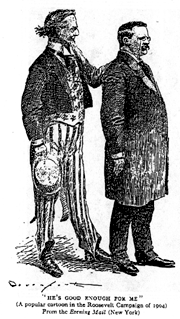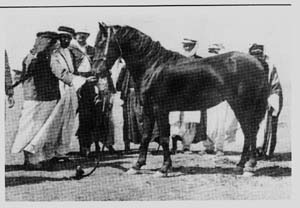| Though
a good portion of Davenport's work lampooned political figures, he greatly
admired Theodore Roosevelt, and endorsed him with his most famous cartoon,
"He's good enough for me," the largest vote-getting cartoon of
all time. By this time, Davenport was working for the New York Mail.
While
still presiding at the Morris Plains estate, Davenport, armed with a letter
from his friend Roosevelt to the Sultan of Turkey, and financed by Boston
millionaire Peter Bradley, went to the Arabian desert for the express purpose
of selecting Arabian horses for importation to the United States. He was
obsessed with acquiring 'real' Arabian horses from the 'real' source, and
his impatience resulted in a trip to the desert at the hottest time of
the year. Yet, it was only during the summer that the Anazeh tribes were
easily accessible.
Con't
The Davenport Arabians... How They Came to Be. Part II
Arabian Horse Express July, 1992
 In
the June issue of the Express on page 23 we covered American political
cartoonist Homer Davenport's early life, including his successful career
with the Hearst newspapers. It was Davenport's cartoon "He's good
enough for me," showing Uncle Sam patting President Theodore Roosevelt
on the back, that won Roosevelt re-election. Roosevelt, grateful to Davenport,
presented him with a letter to the Sultan of Turkey, and financed by Boston
millionaire Peter Bradley, Davenport went to the Arabian desert to select
Arabian horses for importation to the U.S. In
the June issue of the Express on page 23 we covered American political
cartoonist Homer Davenport's early life, including his successful career
with the Hearst newspapers. It was Davenport's cartoon "He's good
enough for me," showing Uncle Sam patting President Theodore Roosevelt
on the back, that won Roosevelt re-election. Roosevelt, grateful to Davenport,
presented him with a letter to the Sultan of Turkey, and financed by Boston
millionaire Peter Bradley, Davenport went to the Arabian desert to select
Arabian horses for importation to the U.S.
Part Two: The Importation
So
eager was Davenport to select horses, that instead of waiting to be introduced
to Governor Nazim Pasha, he ignored protocol and called upon the Bedouin
Sheikh Akmet Haffez. Unbeknownst to Davenport, Haffez was the official
diplomatic representative of the Anazah tribes to the Turkish Government
in Aleppo. Haffez, flattered by Davenport's gesture, sponsored and personally
aided him in his acquisition of horses.
On
Oct. 7, 1906, Davenport returned to America with 27 horses (17 stallions
and 10 mares), and the slave boy, Said Abdullah, to care for the horses.
Of the 27 horses, only 25 were eventually registered, including one in
utero.
*Abbeian, an 1889 grey
stallion of the Abayyan-Dahwan strain. Sire of Jadaan, Sheria and Ashmar.
*Abeyah, an 1896 bay mare
of the Abayyah-Sharrakiyah strain. Dam of the *Haffia and Hejas. This incredible
mare was taken in war from the Shammar tribe by the anazeh tribe. She was
known for carrying 300 pounds over 35 miles in 4 1/2 hours.
*Antar, a 1903 grey stallion
of the Saqlawi-Ubayri strain. Sire of Joon.
*Deyr, a 1904 chestnut
stallion of the Abayyan-Sharrak strain. Sire of Amran, Harara, Hejas, Hanad,
Saba and Satwan.
*El Bulad,
a 1903 grey stallion of the Jilfan-Sitam strain. Sire of Dahura and Fartak.
This stallion was of rare beauty and conformation. His dam was highly regarded
as a war mare and it required a great deal of persuasion by Akmet Haffez
for the Anazeh to sell him.
*Enzahi, a 1906 bay mare
of the Hadbah-Inzihiyah strain. Daughter of *Hadba.
*Euphrates, a 1905 chestnut
stallion of the Saqlawi-Jidran strain. Full brother to *Hamrah.
*Farha, a 1900 grey mare
of the Mu'niqiyah-Sbailiyah strain. Dam of Fartak and Kokhle.
*Gomusa, a 1903 brown stallion
of the Kuhaylan-Haifi strain. Sire of Killah. This stallion was presented
to Davenport by Hickmet Bey, son of the Governor of Aleppo.
*Hadba, a 1900 brown/bay
mare of the Hadbah-Inzihiyah strain. Dam of Meleky and Killah.
*Haffia, a 1906 chestnut
mare of the Abayyah-Sharrakiyah strain. Dam of Harara, Saba, Samit and
Satwan. Akmet Haffez presented this mare to Davenport. Her sire was held
in such high esteem that the Anazeh refused to set a price on him for the
Italian government in 1906.
*Haleb, a 1901 brown stallion
of the Mu'niqi-Sbaili strain. Sire of Meleky, Rhua and Saleefy. *Haleb
was known as 'Pride of the Desert," and was presented to Davenport
by Nazim Pasha who had received him as a gift in recognition of his liberal
camel tax.
 In
his journal, Davenport noted that more than 200 mares were in foal to *Haleb.
Upon his arrival home, Davenport made an entry on the porch clapboards
which contained "It was the realization of my childhood dream when
I saw Manake Sebele (*Haleb), the Pride of the Desert, enter these gates." In
his journal, Davenport noted that more than 200 mares were in foal to *Haleb.
Upon his arrival home, Davenport made an entry on the porch clapboards
which contained "It was the realization of my childhood dream when
I saw Manake Sebele (*Haleb), the Pride of the Desert, enter these gates."
*Hamrah, a 1904 bay stallion
of the Saqlawi-Jidran strain. Sire of Moliah, Jeremah, Dahanah, Hasiker,
Sankirah, Sedjur, Morfda, Poka, Adouba, Fasal, Tamarinsk, Kokhle, Mershid,
Ziki, Kilham, Amham, Sherah and Halloul.
*Houran,
a 1902 bay stallion of the Kuhaylan-Tamri strain. Sire of Bint Nimhaarah.
*Jedah, a 1902 brown mare
of the Hamdaniyah-Simriyah strain. Dam of Letan.
*Kusof, a 1904 bay stallion
of the Mu'niqi strain. sire of Samit.
*Masoud, a 1903 grey stallion
of the Saqlawi-Jidran strain. This stallion was used for three years by
Randolph Huntington on his Clay-Arabs (part-breds) which later became a
part of the Standard-bred breed in America.
*Moharra, a 1907 chestnut
stallion of the Abayyan-Sharrak strain. He was imported in utero with *Abeyah.
He left no descendants.
*Mawarda, a 1904 grey stallion
of the Kuhaylan-Ajuz strain. This stallion left no descendants. His dam,
owned by the Anazeh, was not for sale at any price, nor were her fillies
permitted to leave the tribe's possession.
*Muson, an 1899 grey stallion
of the Kuhaylan-Abu-Muhsin strain. Sire of Letan This stallion descended
from the "listening" horses. As the Bedouin legend states, there
was a historic mare that stood listening, ignoring food given to her by
the Bedouins. On that night, the most horrendous massacre in Bedouin history
occurred and that mare and only a few Bedouins escaped. In 1907, *Muson
was ridden by Buffalo Bill Cody during his Wild West show, and created
quite a sensation at Madison Square Garden.
*Reshan, an 1896 grey mare
of the Kuhaylah-Haifiyah strain. Dam of Hasiker.
*Urfah, an 1898 bay mare
of the Saqlawiyah-Jidraniyah strain. Dam of *Euphrates, *Hamrah, Saleefy,
Sheria and Rhua. Akmet Haffez regarded this mare as the best of her strain
in the northern desert. Several attempts to purchase this mare were made,
and in the end, with the aid of soldiers, she was taken by force. Her purchase
created quite a stir among the tribes.
*Wadduda, an 1899 chestnut
mare of the Saqlawiyah-Al-Abd strain. Dam of Moliah, Aared and Amran. Akmet
presented this mare to Davenport. This mare had been the great war mare
of Hashem Bey, Sheikh of all Sheikhs.
*Werdi, a 1903 chestnut
mare of the Kuhayah-Kurush strain. Dam of Tamarinsk.
Davenport
Arabians are the prime foundation for American Arabian breeding. Davenport
blood is found in the pedigrees of the well known American Arabians such
as Ferzon, Tsali, Ibn Hanrah, Fadjur, Khemosabi, Bint Sahara, Saki and
Kisronna to name a few. The breeding programs of McCoy, Kellogg, Gainey,
Sunny Acres, Donoghue, Payne, Tone and Crabbet-Maynesboro-Kellogg have
all used Davenport blood as a key ingredient.
Certainly
a pioneer for his time, Homer Davenport realized his dreams, and in doing
so, he left us this wonderful legacy.
Back to: Articles of History
Back to: Craver
Chronicles
|
 In
his journal, Davenport noted that more than 200 mares were in foal to *Haleb.
Upon his arrival home, Davenport made an entry on the porch clapboards
which contained "It was the realization of my childhood dream when
I saw Manake Sebele (*Haleb), the Pride of the Desert, enter these gates."
In
his journal, Davenport noted that more than 200 mares were in foal to *Haleb.
Upon his arrival home, Davenport made an entry on the porch clapboards
which contained "It was the realization of my childhood dream when
I saw Manake Sebele (*Haleb), the Pride of the Desert, enter these gates."